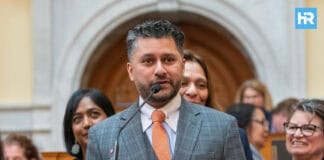Like many other school districts nationwide, Jersey City faces an increasingly difficult challenge: a shortage of teachers.
To deal with this, they’ve started using virtual teachers to keep their classes running smoothly.
This shows just how serious the teacher shortage has become and how schools are finding new ways to give students the education they need, even with fewer teachers.
- Jersey City schools are turning to virtual teachers because of a need for in-person staff.
- Virtual teaching is becoming more common across New Jersey, but concerns about its long-term effects exist.
- Schools are still looking for in-person teachers and are using virtual teachers as a short-term solution.
Jersey City Schools Go Remote to Deal with Teacher Shortage
The new school year has been a little rocky for Jersey City as the district struggles to deal with a serious teacher shortage, which many schools nationwide are also facing.
To ensure classrooms run smoothly, Jersey City schools have brought in remote teachers to fill the gaps, especially in high school subjects like general and special education.
Since the COVID-19 pandemic, retaining teachers has become a nationwide issue. Many educators have left for higher-paying districts or even abandoned the profession entirely. At the same time, fewer people are choosing to become teachers.
To keep students learning, Jersey City has used a combination of live virtual lessons from certified teachers and in-person help from substitute teachers in the classroom.
Essentially, this hybrid method is a temporary fix until they can hire full-time teachers.
For now, the district has already set aside $578,000 to run this program in all four of its high schools.
Ultimately, the idea is to ensure students still get proper lessons, even if the teacher isn’t physically in the room.
Virtual Teaching: A Short-Term Solution to a Bigger Problem
Jersey City isn’t the only place turning to online teaching to handle the teacher shortage. Across New Jersey, many schools are doing the same thing.
However, some worry that this temporary fix could become a long-term one.
During a meeting of state lawmakers, school leaders, teachers, and companies that provide virtual learning stories about how remote teaching is being used in schools.
Most superintendents said they see it as a last resort, used only when all other options—like hiring new teachers or having current staff take on extra classes—have been tried and failed.
For most districts, virtual learning is just a short-term plan, with many still hoping to hire in-person teachers.
Even with this, some are concerned that schools might over-rely on online teaching without clear rules and data.
Concerns Over Long-Term Use of Virtual Learning
While remote teaching is helping schools get by right now, there’s growing concern that it might stick around for too long.
The New Jersey Education Association (NJEA), the state’s biggest teachers’ union, worries that virtual learning could become the new normal if schools aren’t careful.
One big issue is that nobody knows exactly how much virtual learning is happening in schools.
Since each district makes its own deals with virtual learning providers, there is no statewide data on the number of students learning online and for how long.
And this lack of info has many people pushing for new laws to regulate online teaching better.
In some schools, students have live virtual lessons, while others work through online materials at their own pace.
In one physics class, students ended up in what felt more like a study hall, with little hands-on learning and more time spent on work for other classes.
Companies Step in to Support Schools with Remote Learning
As more schools struggle to find enough teachers, companies like Proximity Learning and Imagine Learning are offering online teaching services.
Proximity Learning, for example, provides live virtual lessons from certified teachers who follow the local school district’s curriculum.
Currently, the company has over 40 clients in New Jersey alone and sees itself as a backup plan for schools while they look for full-time teachers.
Many of their remote teachers are retirees or people on temporary leave from teaching, making it easier for them to work part-time and still help out.
Imagine Learning, another online provider, works with around 24 New Jersey districts. Both companies emphasize that their services are meant to support schools in the short term, not replace traditional teaching.
Interestingly, these online teaching jobs are becoming more popular with younger teachers who want more flexibility.
Many teachers, especially millennials, enjoy the freedom to teach from anywhere and have a more flexible lifestyle.
What’s Next for Virtual Teaching in New Jersey?
As Jersey City and other New Jersey school districts face a teacher shortage, virtual learning has become an essential backup plan.
While it’s helping schools cope, concerns remain about its long-term impact.
Schools are still searching for full-time, in-person teachers, but remote learning keeps classrooms running and ensures students don’t fall behind.






